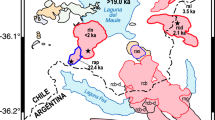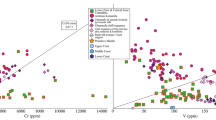Abstract
The occurrence and mineral chemistry of chromite and its high-pressure phase xieite in the Suizhou meteorite were studied by different modern micromineralogical techniques. Three types of occurrences for chromite were observed in the Suizhou L6 chondrite: coarse chromite grains, cluster of chromite fragments in molten plagioclase, and exsolution lamellar chromite in olivine. All the chromite grains of the first two types are remarkably similar in chemical compositions, but the composition of exsolution chromite is inhomogeneous and variable in Al2O3 content. Xieite is a post-spinel CT-phase of chromite firstly found in the Suizhou meteorite. Three types of occurrences of xieite have also been revealed in this meteorite: coarse xieite grains, complex three-zone-grains consisting of the inner xieite, the intermediate lamellae-like CF-phase and the outer chromite phase, and two-phase-grains consisting of xieite and one of the high-pressure silicate minerals lingunite, ringwoodite or majorite. The curved boundary between xieite and the silicate half in two-phase grains is indicative of some partial or even full melting of the silicate phase. EPMA and EDS results show that the compositions of xieite inside/contacting the shock veins are also identical to that of chromite outside the veins. However, some element diffusion appeared in between the xieite and the silicate half in the two-phase grains, namely, some of Al3+ from lingunite, or Fe2+ from ringwoodite migrated to xieite, and some of Cr3+ migrated from xieite to lingunite or ringwoodite. Majorite in two-phase grains shows remarkable decrease of SiO2 and MgO, and notable increase of Al2O3 and CaO, indicating that its host mineral pyroxene was fully molten and mixed with the surrounding silicate melt of the vein matrix. The complexity in mineral chemistry of these two-phase grains in shock veins can be explained by the much higher shock peak temperature in shock veins (1800–2000°C) than in unmelted main body (∼1000°C), and by the much lower density of the silicate minerals (2.6–3.3 g/cm3) than that of chromite (4.43 g/cm3). Being a refractory and a relatively high-impedance material, chromite is chemically more stable and easier to reflect shock wave into the silicate half causing the partial or even full melting of silicate phases, upon which some diffusion of elements between the two phases themselves, or even mixing of molten pyroxene and the surrounding silicate melt.
Similar content being viewed by others
References
Ramdohr P. Chromite and chromite chondrules in meteorites—I. Geochim Cosmochim Acta, 1967, 31: 1961–1967
Ramdohr P. The Opaque Minerals in Stony Meteorites. Amsterdam: Elsevier Press, 1973. 245
Rubin A E. Chromite-plagioclase assemblages as a new shock indicator: Implications for the shock and thermal histories of ordinary chondrites. Geochim Cosmochim Acta, 2003, 67: 2695–2709
Brearley A J, Jones R H. Chondritic meteorites. Rew Mineral, 1998, 36: 6–37
Tassin W. On meteorite chromites. Proc U S Nat Mus, 1908, 34: 685–690
Bunch T E, Keil K, Snetsinger K G. Chromite composition in relation to chemistry of ordinary chondrites. Geochim Cosmochim Acta, 1967, 31: 1569–1582
Jérémine E, Orcel J, Sandréa A, et al. La meteorite de Dosso (République du Niger). Geochim Cosmochim Acta, 1964, 28: 1119–1124
Buseck P K, Mason B, Wiik H B. The Farmington meteorite—Mineralogy and chemistry. Geochim Cosmochim Acta, 1966, 30: 1–8
Snetsinger K G, Keil K, Bunch T E. Chromite from “equilibrated” chondrites. Am Min, 1967, 52: 1322–1331
Wang R J, Li Z H. Comprehensive studies on the Suizhou Meteorite. Wuhan: China University of Geosciences Press, 1990. 1–62
Wang D D. Introduction to Chinese Meteorites (in Chinese). Beijing: Science Press, 1993. 1–505
Xie X D, Chen M, Wang D Q. Shock-related mineralogical features and P-T history of the Suizhou L6 chondrite. Eur J Mineral, 2001, 13: 1177–1190
Xie X D, Chen M, Wang D Q, et al. NaAlSi3O8-hollandite and other high-pressure minerals in the shock melt veins of the Suizhou L6 chondrite. Chin Sci Bull, 2001, 46: 1121–1126
Xie X D, Chen M, Dai C D, et al. A comparative study of naturally and experimentally shocked chondrites. Earth Planet Sci Lett, 2001, 187: 345–356
Xie X D, Minitti M E, Chen M, et al. Natural high-pressure polymorph of merrillite in the shock vein of the Suizhou meteorite. Geochim Cosmochim Acta, 2002, 66: 2439–2444
Xie X D, Minitti M E, Chen M, et al. Tuite, γ-Ca3(PO4)2, a new phosphate mineral from the Suizhou L6 chondrite. Eur J Mineral, 2003, 15: 1001–1005
Xie X D, Shu J F, Chen M. Synchrotron radiation X-ray diffraction in-situ study of fine-grained minerals in shock veins of Suizhou meteorite. Sci China Ser D-Earth Sci, 2005, 48: 815–821
Xie X D, Chen M, Wang D Q, et al. Melting and vitrification of plagioclase under dynamic high pressures (in Chinese with English abstract). Acta Petrol Sin, 2006, 22: 503–509
Chen M, Xie X D, El Goresy A. A shock-produced (Mg,Fe)SiO3 glass in the Suizhou meteorite. Meteor Planet Sci, 2004, 39: 1797–1808
Chen M, Shu J F, Xie X D, et al. Natural CaTi2O4-structured FeCr2O4 polymorph in the Suizhou meteorite and its significance in mantle mineralogy. Geochim Cosmochim Acta, 2003, 67: 3937–3942
Chen M, Shu J F, Mao H K, et al. Natural occurrence and synthesis of two new postspinel polymorphs of chromite. Proc Natl Acad Sci, USA, 2003, 100: 14651–14654
Chen M, Shu J F, Mao H K. Xieite, a new mineral of high-pressure FeCr2O4 polymorph. Chin Sci Bull, 2008, 53: 3341–3345
Agee C B, Li J, Shannon M C, et al. Pressure-temperature phase diagram for Allende meteorite. J Geophys Res, 1995, 100: 17725–17740
Chen M, Sharp T G, E1 Goresy A, et al. The majorite-pyrope+magnesiowustite assemblage: Constrains on the history of shock veins in chondrites. Science, 1996, 271: 1570–1573
Knot A N, Ivanova M A, Wasson J T. The origin of chromatic chondrules and the volatility of Cr under a range of nebular condensats. Earth Planet Sci Lett, 1991, 119: 569–584
Funamori N, Jeanloz R, Nguyen J H, et al. High-pressure transforms in MgAl2O4. J Geophys Res, 1998, 103: 20813–20818
Author information
Authors and Affiliations
Corresponding author
Rights and permissions
About this article
Cite this article
Xie, X., Chen, M. & Wang, C. Occurrence and mineral chemistry of chromite and xieite in the Suizhou L6 chondrite. Sci. China Earth Sci. 54, 998–1010 (2011). https://doi.org/10.1007/s11430-011-4199-9
Received:
Accepted:
Published:
Issue Date:
DOI: https://doi.org/10.1007/s11430-011-4199-9




